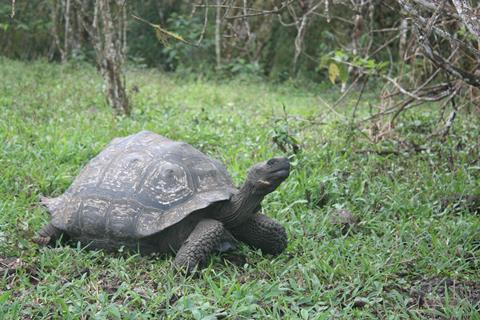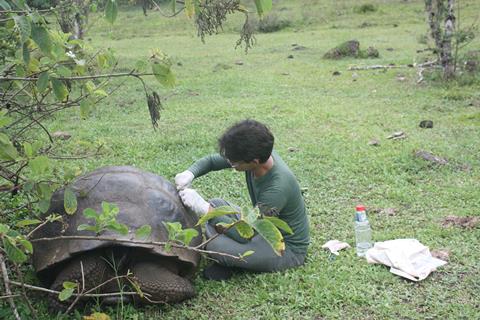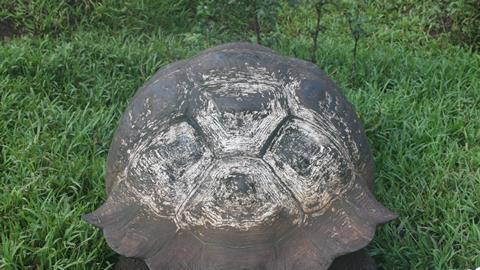The Galapagos giant tortoises are not only a marvel of nature but also a symbol of conservation efforts, inspiring scientists around the globe to protect endangered species. They are living relics of a time when these slow-moving giants roamed the continents.
However, these ancient reptiles carry with them more than just their immense size and history: on their shells there exists an entire, microscopic ecosystem that until recently has not been explored. Through our recent research, we sought to explore the bacterial microbiome found on the shells of three species of these tortoises. What we discovered not only sheds an initial light on their microbiome, but also highlights the interaction that occurs between tortoises, fungi, and bacteria. To deeply appreciate the relevance of this investigation, it is important to understand the long, complex, and bloody history of the Galapagos tortoises, the decades of effort to recover their populations, and the threats they still face today.
The history of Galapagos giant tortoises
Millions of years ago, the ancestors of today’s Galapagos giant tortoises were abundant across continents. Fossil evidence suggests that giant tortoises once roamed in South America, Asia, and Africa. Over time, some tortoises found their way to the volcanic archipelago of the Galapagos, where they eventually evolved into several species. The isolation of the islands forced these reptiles to adapt to unique and diverse environments, resulting in the giant, dome-shaped and saddle-backed tortoises we recognize today.
When Charles Darwin visited the archipelago in 1835, he observed that tortoises were different across the islands, which later contributed to his theory of natural selection. At that time, the tortoise population was still relatively robust but soon after, human activity began to take a toll on these remarkable creatures. European sailors and whalers arrived in the Galapagos Islands at the end of the 18th century and found that tortoises could be used as a vital source of food during long voyages. They can survive for months without food or water, making them the perfect provision for overseas expeditions. As a result, thousands of tortoises were removed from the islands, reducing up to 90% of their populations. At the same time, the introduction of invasive species, such as rats, pigs, and goats, further devastated tortoise habitats. These animals either preyed on tortoise eggs and hatchlings or competed for food resources.

By the mid-20th century, Galapagos giant tortoises were on the brink of extinction; one species was already gone on Floreana Island and Lonesome George was the only individual surviving on his little island, Pinta. In 1959, a combination of national and international efforts created the Galapagos National Park and the Charles Darwin Foundation, which worked together for decades to protect and restore giant tortoise populations. More than 60 years of extensive breeding and conservation programs have brought some light to the future of these unique reptiles. Their numbers have significantly grown, and invasive species have been removed or are under control in the archipelago.
In recent years, an increased tourist industry has created new challenges for these giants. Habitat loss and fragmentation, climate change, illegal trade, the impact of cars, and the spread of diseases have become new threats to these and other endemic species in the archipelago.
Galapagos tortoises as ecosystem engineers
Galapagos giant tortoises play an essential role as ecosystem engineers in the islands they inhabit. By grazing in different areas at different times, tortoises prevent overgrazing in any one location, ensuring that no single plant species dominates. This careful balancing act helps maintain the overall health of the Galapagos ecosystem.
One of the most fascinating aspects of giant tortoise ecology is their migration behavior. In some islands, they are known to migrate seasonally, walking from lowlands to highlands every season in response to climate and food availability changes. During the dry season, they tend to stay in the lush highlands where vegetation is abundant, while in the rainy season, tortoises migrate to the lowlands to feed on highly nutritive plants and fruits, where females also lay their eggs during the nesting season. This movement, often covering distances of more than 10km, helps them not only to survive and stay healthy but also aids in the long-distance dispersal of seeds.
They are aptly named the gardeners of the Galapagos for a reason.
As they migrate, tortoises create paths through the dense undergrowth that other species, both animal and plant, rely on. In some areas, tortoises even shape the physical landscape by modifying the terrain with their heavy bodies, which can create small depressions that collect rainwater, benefiting other species during the dry season.
Unfortunately, the decline in tortoise populations over the centuries has disrupted these natural processes. Without their widespread grazing, seed dispersal, and migration, the health of the entire Galapagos ecosystem is compromised. This highlights the importance of conservation efforts to restore tortoise populations and maintain their health and well-being.
The role of microbiomes in animal health
The scientific community is increasingly recognizing the crucial role of microorganisms in sustaining animal health and well-being. Microbiomes are the diverse communities of bacteria, fungi, and other microorganisms that live on and within an organism. These tiny life forms are invisible to the naked eye, but they have a profound impact on the overall health of any living creature.
In humans, for instance, we have learned that our gut microbiome influences not only digestion but also immunity, metabolism, and even mental health. Similarly, the microbiomes found on the skin, fur, feathers, or scales of animals can affect their ability to resist disease, heal wounds, and interact with their environment. These microbial ecosystems are integral to maintaining health and protecting against pathogens.
Sea turtles for example, which share some similarities with their land-dwelling relatives, harbor unique microbiomes that influence their health and their interactions with the marine environment. Their shells serve as “mobile habitats” for various marine organisms, including algae, barnacles, and small fish. These organisms likely interact with the microbial communities on the turtles’ shells, creating a dynamic ecosystem where microorganisms contribute to the health of the turtle and the health of the surrounding marine environment.
The carapace or shell of Galapagos tortoises is a vital part of their body, providing protection from predators and environmental hazards. However, it is not just a physical shield—it also houses a complex microbial community. A specific concern for these gentle giants is the presence of the fungus Aphanoascella galapagosensis which causes areas of whitish discoloration and desquamation on their shells. The presence of this fungus raises important questions about its interaction with the tortoise’s microbiome. While some fungi can be pathogenic, potentially leading to health issues, the specific effects of A. galapagosensis on tortoise health are still being investigated.
Despite this concern, the role of the microbiome on the shells of giant tortoises remains understudied. This area of research holds the potential to reveal important insights into how these animals maintain their health in the wild. Just as a balanced gut microbiome promotes human well-being, a stable and diverse microbial community on a tortoise’s carapace may be critical to its overall health status. Disruptions to this delicate microbial balance – whether due to fungal growths, environmental stressors, or other external factors – could have negative consequences for tortoise survival. Additionally, understanding the microbiome in animals like the Galapagos giant tortoise not only opens new avenues for studying their health but also contributes to broader conservation efforts. By exploring the microorganisms living on these ancient reptiles, we can better understand the hidden aspects of their biology that might be key to ensuring their survival in the face of modern environmental changes.
Exploring the microbiome of Galapagos tortoises
In our recent research, we set out to explore the bacterial microbiome associated with the carapaces of three Galapagos giant tortoise species: Chelonoidis porteri and Chelonoidis donfaustoi from Santa Cruz Island and Chelonoidis vandenburghi from Isabela Island. Using advanced DNA sequencing techniques, specifically Oxford Nanopore’s MinION, we were able to identify and classify the bacteria living on the tortoises’ shells.

One of the primary goals of our study was to determine how fungal lesions — caused by the fungus Aphanoascella galapagosensis — affect the bacterial populations on the tortoise’s carapaces. These lesions appear as whitish patches on their shells, and while they may seem harmless at first glance, we suspected they were disrupting the delicate balance of the shell’s microbiome. To test this, we compared the bacterial communities on tortoises with fungal lesions to those with healthy shells.
The results showed a clear tendency: while all tortoises shared a group of bacterial genera that were consistent across individuals, the tortoises with fungal lesions showed significant differences in their microbial communities. In samples where fungal lesions were present, we observed an increase in bacterial richness and diversity. While this greater diversity might initially seem beneficial, it’s important to consider that some of the bacteria associated with these lesions could potentially be pathogenic or produce cyanotoxins, which can be harmful to the tortoises’ health. On the other hand, fewer bacterial genera were prevalent in carapaces without lesions, indicating that unaffected carapaces may harbor a more limited microbial diversity. This may be due to the harsh conditions of the carapace itself.
The presence of potentially harmful microorganisms in lesioned carapaces underscores the complexity of the tortoise microbiome. Increased diversity does not necessarily equate to improved health; instead, it may indicate an imbalance that could lead to health challenges. For example, the presence of bacteria known to produce toxins can pose serious risks, as these toxins can have detrimental effects on animal health.
Overall, the relationship between bacteria and fungus highlights the interconnectedness of microorganisms within the tortoises’ ecosystems and offers novel insights into the ecological dynamics involved.
While our investigation serves as an important first step in describing the external microbiome of Galapagos giant tortoises, it highlights the need for additional research to elucidate the intricate relationships between tortoises, their carapace-associated microorganisms, and the environmental factors at play. Understanding these dynamics is crucial for the effective conservation and management of these emblematic reptiles, ensuring they continue thriving in the archipelago.

The future of microbiome research and conservation
Gaining insight into the microbiome of wildlife species introduces new opportunities for conservation research. Just as studying human microbiomes has led to advances in healthcare, understanding the microbiomes of endangered species can improve how we protect them in the wild and under human care.
For the Galapagos tortoises, monitoring their bacterial communities could provide early indicators of health issues or environmental changes. If fungal growth is found to significantly alter the tortoises’ microbiome, conservation efforts could include strategies to maintain or restore healthy microbial balances. There is also potential for microbiome research to contribute to disease prevention. As with any living organism, tortoises are susceptible to a range of pathogens. If we can better understand how their microbiome interacts with these pathogens, we might be able to develop targeted interventions to prevent the spread of diseases that could threaten tortoise populations.
Ultimately, the findings from this research have implications beyond the Galapagos tortoises. By understanding the microbiomes of these ancient reptiles, we can develop conservation strategies that may benefit other endangered species facing similar challenges, which in turn can enhance our understanding of ecological interactions and promote the health of entire ecosystems.
Conclusion: a hidden world with big implications
Our research into the microbiome of Galapagos giant tortoises has been a journey into the unseen world of microorganisms that play an essential role in the health and survival of these ancient creatures. The discovery that fungal lesions can disrupt the bacterial balance on their carapaces highlights the importance of maintaining healthy microbial communities as part of broader conservation efforts.
As we continue exploring the microbiome of animals, from tortoises to other endangered species, we will gain new tools to understand and ultimately protect the biodiversity of our planet. The Galapagos tortoises have survived for millions of years, adapting to unique conditions and surviving human exploitation. Hopefully, by studying their microbiome and its implication to their overall health and well-being, we will contribute to the long-term conservation of these fascinating reptiles.








No comments yet